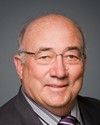Right.
Well, as you know, Mr. Richardson and his wife, of Ottawa, suffered a severely unfortunate loss. I was very proud to see the House leader of the Conservative Party, as well as members from all parties, gather yesterday in solidarity, not just in the House, but at a press conference that was held in the lobby of the foyer of the House of Commons. Six of our colleagues were wearing hockey jerseys. It was quite a show of support for the family in that regard.
The government also should be congratulated for what they did a couple of years ago when they instituted what was called the national cancer strategy, where they coordinated the efforts of the provinces and various organizations to develop best standards practices and everything else. I hear this a lot too--and we all hear it--that health care is a provincial responsibility, but the government has shown once and in several other cases, such as SARS, AIDS, etc., that it is willing to participate in a national system--in this case, cancer.
I think it would only follow that all of us--not just government, but all parliamentarians--must ensure that this very serious public health issue, which unfortunately is growing, and for a variety of reasons, is seriously attended to. It is something that I think we should all look at in that regard. I can't speak for the government; they're very capable of speaking for themselves.
On the veterans' side of the issues, do you have any veterans or military personnel on your volunteer board?




